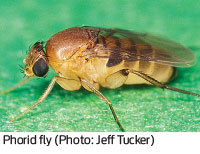Click To Call > (800) 966-7673
Monday, August 15, 2016
 They can run, they can hide, and when they’re found, they are often misidentified. They are phorid flies, and, although they are not the most common pests, they are highly intractable and can be an expensive problem for any home or a business owner. That’s why, at NPMA PestWorld 2012, Mark “Shep” Sheperdigian of Rose Pest Solutions, Richard Berman of Waltham Services, and Jay Bruesch of Plunkett’s Pest Control teamed up to share their insights into how to properly identify and effectively manage the phorid fly.
They can run, they can hide, and when they’re found, they are often misidentified. They are phorid flies, and, although they are not the most common pests, they are highly intractable and can be an expensive problem for any home or a business owner. That’s why, at NPMA PestWorld 2012, Mark “Shep” Sheperdigian of Rose Pest Solutions, Richard Berman of Waltham Services, and Jay Bruesch of Plunkett’s Pest Control teamed up to share their insights into how to properly identify and effectively manage the phorid fly.
Identification. Misidentification is one of the main reasons why many pest technicians are unable to successfully treat phorid flies. According to Sheperdigian, the phorid fly is “Usually accused of being Drosophila or some other fruit fly, which leads to control methods which are less than optimal, which leads to weeks or months or years of ineffective control,” he said. To avoid misidentification, technicians should be aware of the characteristics that are most common among the phorid fly.
Physically, there are three traits that make the phorid stand out. First, phorids are known for their hunched back, which has earned them the name “humpback” fly. This trait, however, is not enough to definitively classify a specimen as a phorid since not all phorids have the humpback and a few non-phorids also share this characteristic.
Instead, says Sheperdigian, technicians often identify the phorid by its unique wing venation. “When you see a phorid wing, you will note that the first few veins are very thick or heavily sclerotized. The rest of the veins are very light and don’t seem to attach to anything. With very few exceptions, there are no cross-veins on phorid wings,” he said.
Read the entire article Figuring Out Phorids in PCT Magazine.
August 3, 2016
Kelly Mannes
kmannes@giemedia.com